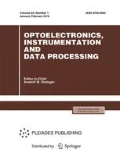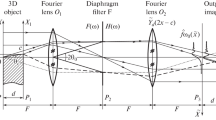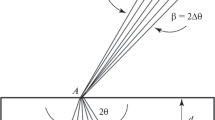Abstract
The peculiarities of image formation of a volume asymmetric ideally absorbing edge, the main fragment of extended (in depth) plates of constant thickness, in diffraction limited projection system are analytically studied with application to the size inspection of 3D objects. The structures and profiles of intensities in the images of the front and rear faces of object are investigated at small and large apertures of the optical system for different relations between the object bevel \(c\), the size of the Fresnel zone \(\delta_{d}\sim\sqrt{\lambda d}\) (\(\lambda\) is the wavelength of light and \(d\) is the object thickness), and angular aperture of the optical system \(2\theta_{0}\). In the case when the bevel \(c\ll\delta_{d}\), at large focal depth of the system the intensity profile is displaced in the image of the 3D edge in linear proportion to the Fresnel zone and to the bevel size. It is analytically demonstrated that, for large bevels (\(c\gg\delta_{d}\)) and small apertures of the system in the plane conjugating with the front face, a sharp image of either the front face (the rear face is shadowed) or the rear face (the front face is shadowed by the rear face) is observed. The formulas for the image profile of the rear face are obtained and studied in the case of significant volume effects, when the focal depth of the system is far smaller than the object thickness. The calculation results are in good agreement with the results of computer modeling.






Similar content being viewed by others
REFERENCES
M. Born and E. Wolf, Principles of Optics (Pergamon Press, London, 1959).
H. Hönl, M. Maue, and K. Westpfahl, Theorie der Beugung (Springer-Verlag, Berlin, 1961).
V. A. Borovikov and B. E. Kinber, Geometrical Theory of Diffraction (Svyaz’, Moscow, 1978).
J. B. Keller, ‘‘Geometrical theory of diffraction,’’ J. Opt. Soc. Am. A 52, 116–130 (1962).
Yu. V. Chugui and B. E. Krivenkov, ‘‘Fraunhofer diffraction by volumetric bodies of constant thickness,’’ J. Opt. Soc. Am. A 6, 617–626 (1989). https://doi.org/10.1364/JOSAA.6.000617
J. W. Goodman, Introduction to Fourier Optics (McGraw-Hill, New York, 1968).
Yu. V. Chugui, ‘‘Peculiarities of formation and delimitation of images of volume bodies in coherent light,’’ Avtometriya, No. 4, 103–112 (1991).
Yu. V. Chugui and V. A. Sokolov, ‘‘Formation and filtering in coherent light the images of 3D asymmetric edges,’’ in Proc. 6th ISMQC IMEKO Symp. Metrology for Quality Control in Production, Vienna, 1998, pp. 117–124.
Yu. V. Chugui, ‘‘Calculation of the object edge position after its projection in a spatially noninvariant coherent optical system,’’ Optoelectron., Instrum. Data Process. 52, 570–579 (2016). https://doi.org/10.3103/S8756699016060078
Yu. V. Chugui, ‘‘Calculation and analysis of the pulse response of spatially non-invariant projection systems,’’ Optoelectron., Instrum. Data Process. 54, 557–568 (2018). https://doi.org/10.3103/S8756699018060043
A. Papulis, Systems and Transforms with Applications in Optics (McGraw-Hill, New York, 1968).
Handbook on Special Functions, Ed. by M. Abramov and I. Stishin (Nauka, Moscow, 1979).
Yu. V. Chugui, ‘‘Far field diffraction phenomena on cylindrical objects of small diameter taking into account their reflective properties,’’ Optoelectron., Instrum. Data Process. 56, 350–355 (2020). https://doi.org/10.3103/S8756699020040044
ACKNOWLEDGMENTS
The author thanks E. S. Arsenina for technical aid in preparing this paper.
Funding
The work is supported by the Ministry of Science and Higher Education of the Russian Federation (state registration no. AAAA-A17-117121270018-3).
Author information
Authors and Affiliations
Corresponding author
Additional information
Translated by E. Oborin
About this article
Cite this article
Chugui, Y.V. Calculating the Images of a Volume Asymmetric Ideally Absorbing Edge of an Object in Coherent Light. Optoelectron.Instrument.Proc. 56, 623–633 (2020). https://doi.org/10.3103/S8756699020060060
Received:
Revised:
Accepted:
Published:
Issue Date:
DOI: https://doi.org/10.3103/S8756699020060060




